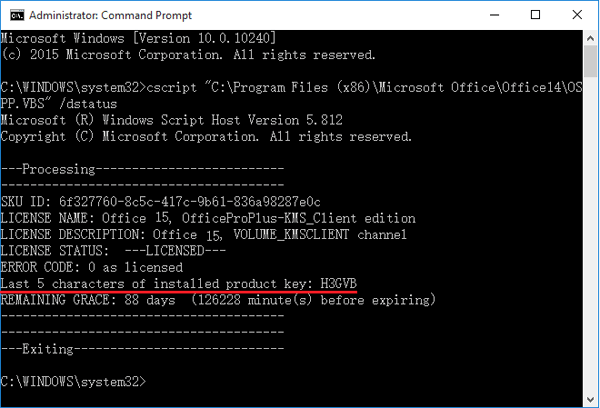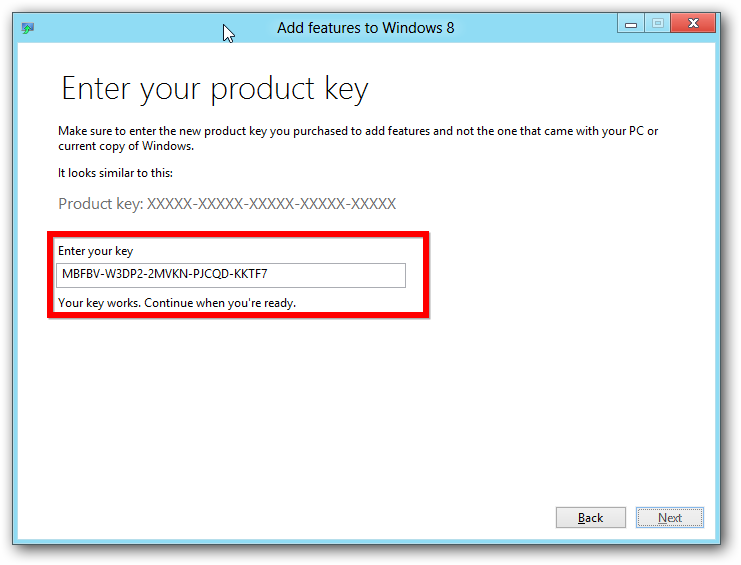
- #FIND OFFICE 2013 PRODUCT KEY IN WINDOWS 8 HOW TO#
- #FIND OFFICE 2013 PRODUCT KEY IN WINDOWS 8 UPDATE#
- #FIND OFFICE 2013 PRODUCT KEY IN WINDOWS 8 OFFLINE#
- #FIND OFFICE 2013 PRODUCT KEY IN WINDOWS 8 CRACK#
OReg.DeleteKey HKEY_CURRENT_USER, sKeyPath 'Delete the cache location from the registry if the on-disk file is not there. 'If we got the location from the registry OReg.GetStringValue HKEY_CURRENT_USER, sKeyPath, "FilePath", sValue 'Find where the on-disk cache data is supposed to be SServiceKeyPath = sCacheKeyPath & "\" & subKey OReg.EnumKey HKEY_CURRENT_USER, sCacheKeyPath, arrsubKeys SCacheKeyPath = "Software\Microsoft\Office\15.0\Common\Internet\WebServiceCache\AllUsers\"

'Location of Office 2013 Web Service Cache data Set oFS = CreateObject("Scripting.FileSystemObject") Set oReg = GetObject("winmgmts:!\\.\root\default:StdRegProv") Result? All users can now log on to any computer and use Office 365 successfully. If the file is missing, it removes the registry entry that refers to it. The script enumerates every entry under the and checks to see if the on-disk cache file is present. Instead, I deployed the below logon script to all my roaming profile users via Group Policy. After all, the cache must be there for a reason, so why reset it when it works?
#FIND OFFICE 2013 PRODUCT KEY IN WINDOWS 8 CRACK#
I toyed with the idea of simply clearing the entire HKCU\Software\Microsoft\Office\15.0\Common\Internet\WebServiceCache\ AllUsers\ key at logon, since there appeared to be no side effects to doing so (other than that Office would actually bloody work properly), but that seemed like a bit of a sledgehammer to crack a nut. If the user then went to a third computer that didn’t have the correct file in the local AppData, the problem would come right back. What fixed itĭeleting the offending key from the registry immediately fixed the problem, but only on that computer. Basically, look at everything under the key.
#FIND OFFICE 2013 PRODUCT KEY IN WINDOWS 8 UPDATE#
That version changes with each cumulative update for Office that is released on Windows update. The exact key name may differ on your system, since it contains references to the Office and system locale IDs (1033 for English US and 2057 for English UK) and also the current build version of the MSO.DLL installed on your system. Which referenced the following file location: C:\Users\teststaff\AppData\Local\Microsoft\Office\15.0\WebServiceCache\AllUsers\\config15-lcid=1033&syslcid=2057&uilcid=1033&build=&crev=10īecause this file doesn’t roam, it was missing from any logon other than on the first computer the account was used on. The offending registry value was: HKEY_CURRENT_USER\Software\Microsoft\Office\15.0\Common\Internet\WebServiceCache\AllUsers\\config15-lcid=1033&syslcid=2057&uilcid=1033&build=&crev=1\FilePath

A direct reference to in the user’s local AppData directory (which doesn’t roam), in a location that was retrieved immediately beforehand from the registry (which does roam). I’ve looked at enough process traces over the years to know a dead giveaway when I see one. I ran Procmon and looked for Word making any direct references to the user’s local copy of their roaming profile on the C:\ drive. That led me to suspect that Word was storing something outside the user’s roaming profile that it was relying on finding again later, but couldn’t find on a different machine because, well, it wasn’t in the roaming profile. the one on which their new roaming profile was created), but the same user would then fail as soon as they used a different computer (with the same roaming profile). When the problem came back again, I found I could also get rid of the problem by deleting the user’s roaming profile from the server, at which point I could sign in to Office 365 on the first computer they used (i.e.

Originally I found that uninstalling some of the Office 2013 updates helped ( KB2768349, KB2767861, and KB2760624), but this turned out to be only a temporary workaround.
#FIND OFFICE 2013 PRODUCT KEY IN WINDOWS 8 HOW TO#
I didn’t find much useful online when searching for this error message, other than a few people having trouble activating the Office 365 Click-to-Run apps, and no-one knew how to fix it.
#FIND OFFICE 2013 PRODUCT KEY IN WINDOWS 8 OFFLINE#
You can work offline if you plan to insert pictures from your computer.”Īfter a couple of hours in the office turning the air blue, I discovered 3 things:

“Sorry, we are having some temporary server issues.


 0 kommentar(er)
0 kommentar(er)
